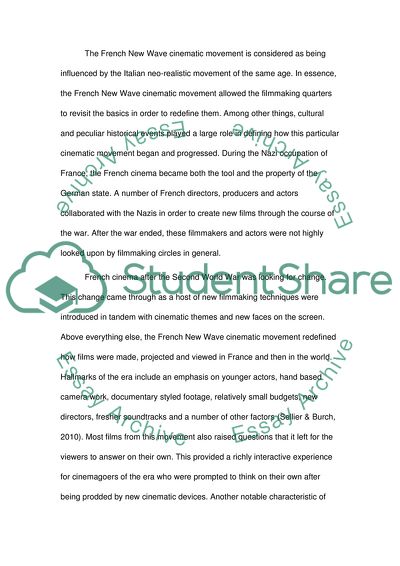Cite this document
(“2)In what ways can French New Wave cinema be considered a product of Essay”, n.d.)
2)In what ways can French New Wave cinema be considered a product of Essay. Retrieved from https://studentshare.org/miscellaneous/1601430-2in-what-ways-can-french-new-wave-cinema-be-considered-a-product-of-its-particular-moment-institutionally-technologically-and-culturally-your-answer-should-make-close-reference-to-one-or-two-films
2)In what ways can French New Wave cinema be considered a product of Essay. Retrieved from https://studentshare.org/miscellaneous/1601430-2in-what-ways-can-french-new-wave-cinema-be-considered-a-product-of-its-particular-moment-institutionally-technologically-and-culturally-your-answer-should-make-close-reference-to-one-or-two-films
(2)In What Ways Can French New Wave Cinema Be Considered a Product of Essay)
2)In What Ways Can French New Wave Cinema Be Considered a Product of Essay. https://studentshare.org/miscellaneous/1601430-2in-what-ways-can-french-new-wave-cinema-be-considered-a-product-of-its-particular-moment-institutionally-technologically-and-culturally-your-answer-should-make-close-reference-to-one-or-two-films.
2)In What Ways Can French New Wave Cinema Be Considered a Product of Essay. https://studentshare.org/miscellaneous/1601430-2in-what-ways-can-french-new-wave-cinema-be-considered-a-product-of-its-particular-moment-institutionally-technologically-and-culturally-your-answer-should-make-close-reference-to-one-or-two-films.
“2)In What Ways Can French New Wave Cinema Be Considered a Product of Essay”, n.d. https://studentshare.org/miscellaneous/1601430-2in-what-ways-can-french-new-wave-cinema-be-considered-a-product-of-its-particular-moment-institutionally-technologically-and-culturally-your-answer-should-make-close-reference-to-one-or-two-films.


